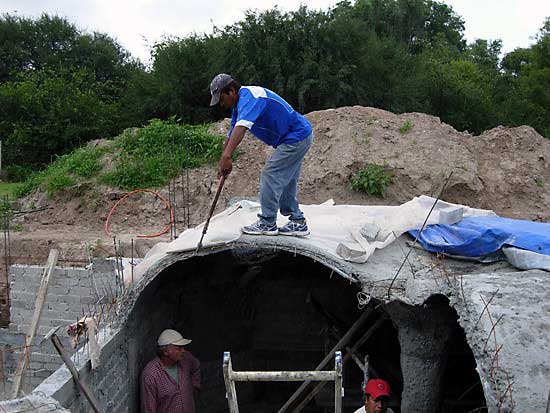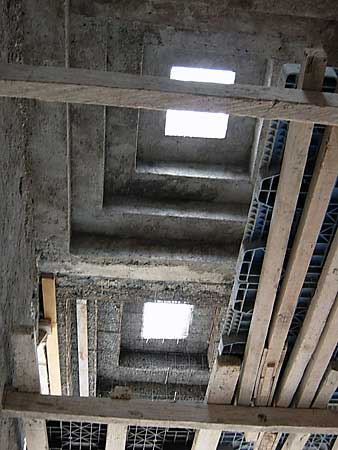MOVABLE FORM WORK
The roofs for these two 50,000 liter water tanks were inspired by Bo's square donut design idea.
Three pours have been made on each tank roof. We next closed in and poured about 2/3 of the remaining open section on each tank and left a small triangle open for finishing the walls of the tanks. The walls are one layer of #66 10 10 WW in 1 inch of mortar and one layer of plaster lath sandwiched inside PVA fibered mortar.Sponge finish
Ready for the initial shell. First we applied a 1/2" coat of mortar (sand, cement, lime) on the formwork as a shell. The next day we poured the structural shell on top
We tested several different membranes as release agents between the metal form work and the concrete shell. Inner tubes, blue tarps, white poly feed sacks and cheap cotton cloth were all tried in an attempt to get a smooth interior finish that doesn't require overhead plastering. Everything we tried was OK for the roof of a water tank but nothing gave us a good enough finish for an interior living space.
We tested several different membranes as release agents between the metal form work and the concrete shell. Inner tubes, blue tarps, white poly feed sacks and cheap cotton cloth were all tried in an attempt to get a smooth interior finish that doesn't require overhead plastering. Everything we tried was OK for the roof of a water tank but nothing gave us a good enough finish for an interior living space.
Removing the formwork. 3/8" rebar , #66 10 10WW and plaster lath. Easy to do with 2 or 3 people for these small vaults.We moved the formwork after curing for only 48 hrs. Once again, small vaults are easy.
The roof pour was 2 1/2", 3,500 psi with one layer of #66 10 10 WW. We used neat cement to bond different pours at the cold joints.
The roof pour was 2 1/2", 3,500 psi with one layer of #66 10 10 WW. We used neat cement to bond different pours at the cold joints. >The roof pour was 2 1/2", 3,500 psi with one layer of #66 10 10 WW. We used neat cement to bond different pours at the cold joints.
Both vaults ready for the initial shell coat. Poly feed sacks used as release.
Movable BV form work -- one half of a long hallway. The square wooden form work (centering) allows passage during construction.
Movable form work for a stepped square roof. This photo is looking almost straight up.Three bays were built using the same form work.
Moveable Form Work
Moveable Form Work
Detail of form work. Pumicecrete was placed on top of form and used to fill the angles. Then a structural dome shape was poured on top












